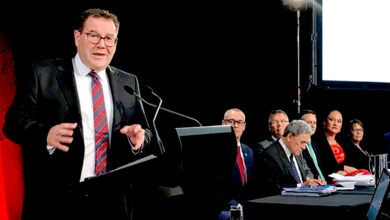Investors Stand Firm on Recession Bets: Painful Trade or Steady Trade?

Pain or gain? The investors are holding strong on their recession bets, refusing to fold. What was once predicted to be the year of underwhelming trades has been turned upside down by the frenzy of AI mania in the stock markets. The anticipated recessions that were expected to ignite fixed income have proven to be elusive.
The slowdown in economic growth was supposed to make this year lackluster for global stocks. However, against all odds, they have soared by 13%, with the ‘big tech’ companies leading the charge with over a staggering 70% increase.
Bonds were expected to rally as recessions prompted interest rate cuts. Yet, contrary to expectations, borrowing costs and 10-year U.S. Treasury yields have climbed higher. Even riskier assets like bitcoin and emerging market debt have outperformed all expectations.
While data suggests that recession risks remain high, wages and interest rates in the U.S. and Europe continue to rise. This leaves investors with a dilemma – should they stick to their current strategies or twist and take a different approach?
Let’s delve into the five significant choices investors are currently making.
1/ STAYING LOYAL TO BONDS
Francesco Sandrini, the head of multi-asset strategies at Amundi, Europe’s largest fund manager, admits that they, along with other asset managers worldwide, got it wrong. They started the year with a positive outlook on Treasuries, positioning themselves for the end of U.S. rate hikes and a downturn in the world’s largest economy. However, their predictions did not come to fruition.
“We may be wrong for another couple of quarters,” Sandrini concedes, acknowledging that a substantial economic slowdown is only a matter of time.
Investors surveyed in January anticipated that 10-year Treasury yields would decline to 3.25% by the end of 2023. However, due to persistent inflation and hawkish central banks, yields have remained higher. Currently, these yields are hovering around 4%. Additionally, U.S., U.S., and British 2-year yields have reached their highest levels since 2007-2008.
Despite these setbacks, Seema Shah, Chief Global Strategist at Principal Global Investors, maintains her belief that government bonds will perform well, given the likelihood of a recession by year-end.
2/ FOMO FEVER IS SPREADING
The fear of missing out (FOMO) has wreaked havoc on equity bears, as the AI frenzy propels the mammoth U.S. tech companies, which now dominate the global indexes, to a staggering 73% combined increase this year.
However, such remarkable gains have led to the largest 10% of U.S. stocks accounting for a staggering 75% of the overall U.S. equity market cap. This level of concentration, as Absolute Strategy Research points out, hasn’t been witnessed since 1932.
JPMorgan issues a warning to its clients about the growing complacency built into stocks, citing the low levels of Wall Street’s ‘fear gauge,’ the VIX volatility index.
Trevor Greetham, Head of Multi-Asset at Royal London Asset Management, bought equities based on contrarian beliefs since October. However, he is now prepared to shift towards bonds and gold.
Florian Ielpo, the Head of Macro at Lombard Odier Investment Managers, remains cautious as key indicators, such as U.S. manufacturing data and European purchasing manager indices, start to sour.
“It’s crucial to understand that sentiment is bullish, but the macroeconomics are bearish. Reconciling the two is a challenge,” he cautions. “Can sentiment drive us forward for another two quarters? I highly doubt it.”
3/ THE YEN’S ASCENDANCE
At the start of 2023, the prevailing FX bet was on the yen’s rise due to anticipated U.S. rate cuts and Japan’s move away from ultra-loose monetary policy.
Yet, as of now, there are no signs of the predicted outcome. The yen, which began the year at around 131 per dollar, has only made a modest move to just under 140 after a brief spike to 145 in late June.
Meanwhile, the dollar index has fallen below January levels as the euro, pound, and Swiss franc experience a rally.
Athanasios Vamvakidis, the Head of G10 FX Strategy at Bank of America, expects the greenback to regain strength, causing the euro to fall to $1.05 from around $1.10. This prediction is based on the Federal Reserve keeping U.S. rates high before the eventual recession bolsters the currency with safe-haven bids. Vamvakidis forecasts the dollar/yen exchange rate to reach 147 by the end of September.
Morgan Stanley has recently turned “tactically bullish” on China’s yuan, reversing their stance following a lackluster start to the year.
4/ CHINA’S FRAGILITY
China’s much-anticipated mini-boom has been hindered by faltering data, troubles in the property market, and tepid economic stimulus.
Stocks in China have underperformed, and ‘junk’-rated Chinese debt, primarily in the property sector, has experienced setbacks.
Contrary to expectations, emerging market local currency debt has delivered an impressive 8% total return year-to-date. This marks one of the strongest six-month performances in the past 10 years. The developing world’s proactive approach in transitioning from rate hikes to cuts has played a significant role in this achievement.
As a result





